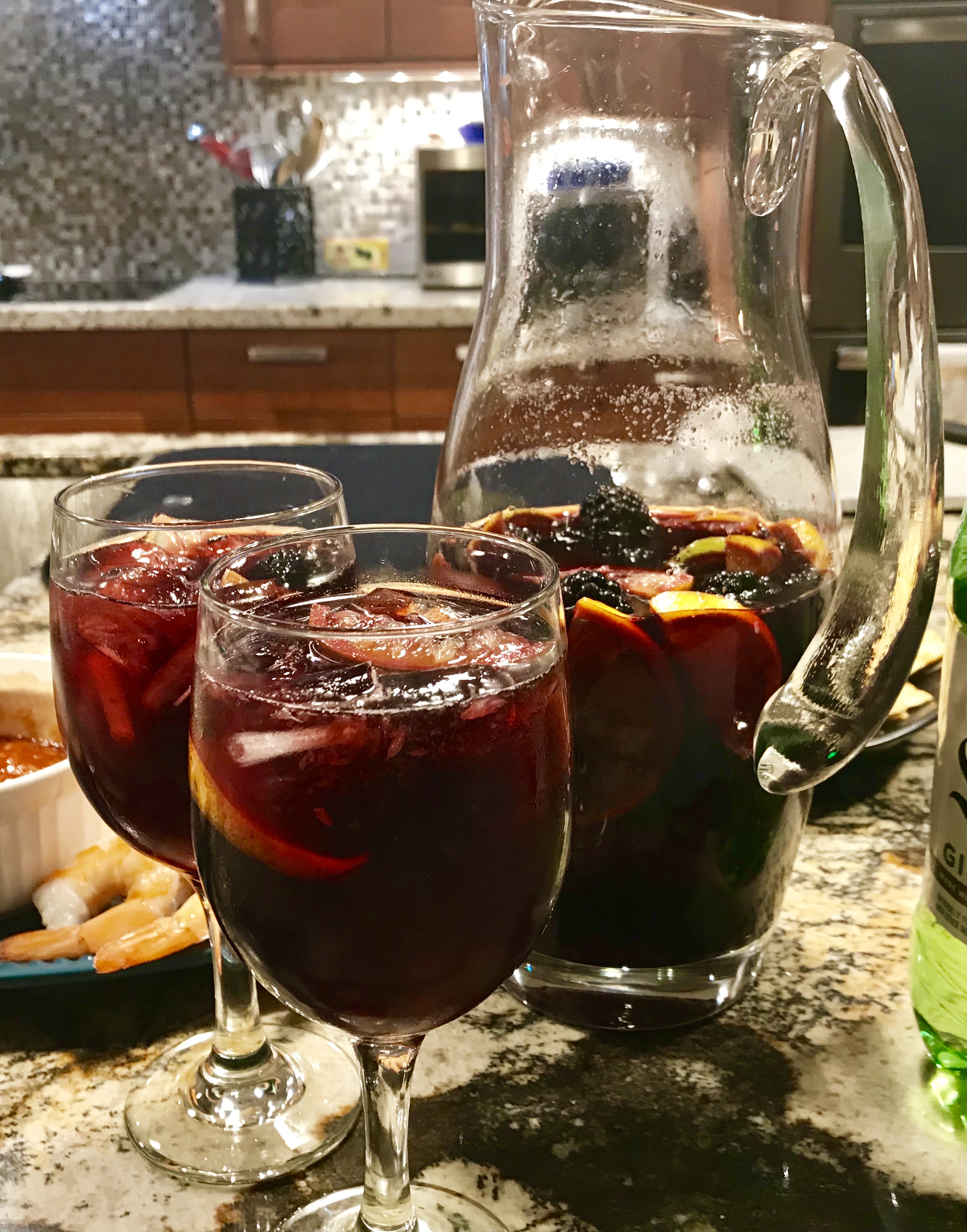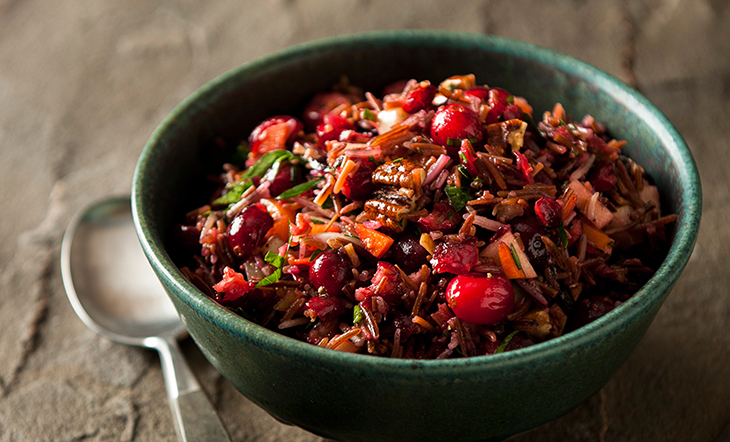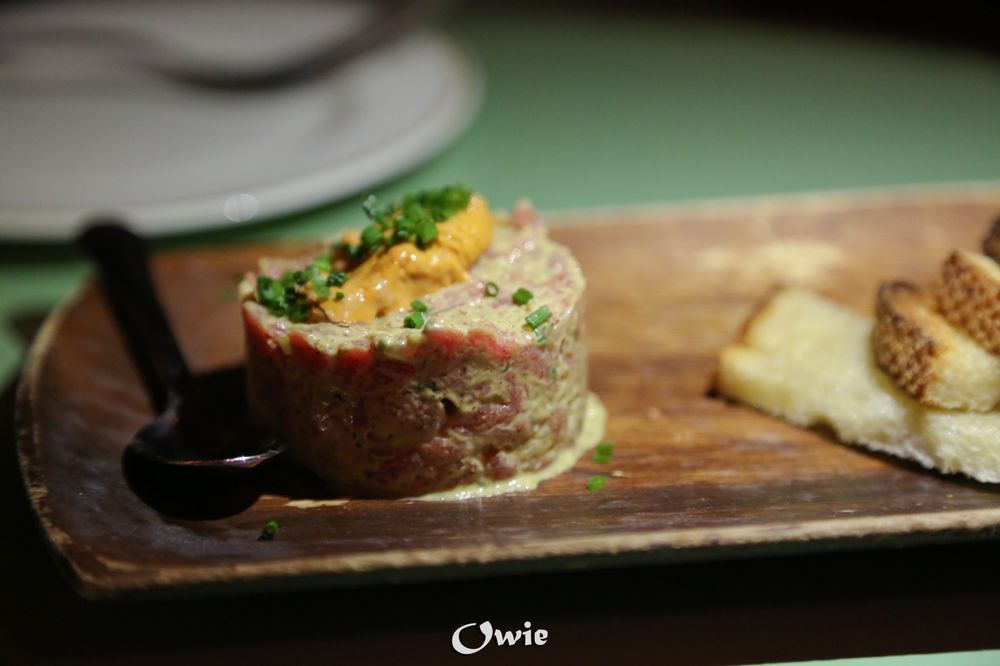Article: James Beard Foundation editors; December 11, 2017 No chestnuts roasting on an open fire? No Jack Frost nipping at your nose? No worries. Just mix up a pitcher (or two) of one of these Yuletide-evoking drinks and you and your guests will be in the holiday spirit in no time.
Mary Rockett's Milk Punch Apparently folks in the 18th century also needed a little tipple to get through the holidays. This traditional recipe, adapted by cocktail expert David Wondrich, dates back to 1711.
Mary Rockett's Milk Punch
This delightfully smooth, liqueur-like formula dates back to 1711.
David Wondrich, Adapted from Imbibe! (Perigee Trade, 2007)
- 2 lemons
- 1 quart V.S. or V.S.O.P. Congac
- 1 cup sugar
- 3 oz lemon juice
- 1 pint whole milk
- 1/2 whole nutmeg, freshly grated
-
Using a vegetable peeler, peel lemons, avoiding the white pith as much as possible. Put the peels in a sealable, 2-quart glass container and pour Cognac over them. Cover and let sit for 48 hours.
Add sugar and lemon juice to the lemon-infused Cognac. Heat whole milk until scalding hot, then add to the cognac mixture and stir until the milk curdles. Stir in the grated nutmeg and let the punch sit for 1 hour.
Strain through fine cheesecloth or paper towels, bottle, and refrigerate. To serve, pour from chilled bottle into sherry glasses. If punch is too thick, add a little seltzer or, during winter, hot water.

Cardamom Old Fashioned A subtle riff on the classic cocktail staple, this version uses maple syrup and cardamom bitters for a warming, fragrant antidote to winter doldrums.
CARDAMOM OLD FASHIONED

A subtle riff on the classic Old Fashioned, this version uses maple syrup in lieu of standard sugar, while handmade cardamom bitters step in for the more traditional Angostura variety, creating a warm, fragrant antidote to winter doldrums.
Elena North-Kelly, Managing Editor, James Beard Foundation
- 2 ounces rye whiskey
- 15 to 20 drops Bob’s Cardamom Bitters
- 1/2 teaspoon maple syrup
- Orange twist (for garnish)
- Pour the first three ingredients into a cocktail shaker.
- Add ice and stir until thoroughly chilled.
- Strain the mixture into a rocks glass, over ice.
-
Garnish with an orange twist, enjoy!
Negroni Sbagliato It's no secret that everyone loves a negroni. Pro tip: just dress up your go-to drink for the holidays with a festive splash of bubbly.
NEGRONI SBAGLIATO

"The legendary Bar Basso in Milan (which originally opened in 1933 and moved to its current space in 1947) claims provenance of this buoyant little cousin to the Negroni, whose sbagliato addendum means “mistaken” or “incorrect” in Italian. Basso’s jovial proprietor Maurizio Stocchetto entertains guests with an origin tale citing his father, Mirko—a legendary midcentury barman and the owner of Bar Basso beginning in 1967—as the “accidental” inventor of the drink in the early 1970s, substituting prosecco for gin. Most impressively, the bar serves its sbagliato in a giant handblown goblet complete with an ice block the size of a car battery." — Talia Baiocchi and Leslie Pariseau
- 1 ounce Campari
- 1 ounce sweet vermouth
- 3 ounces prosecco
- Orange half-wheel for garnish
- Combine the ingredients in a rocks glass over ice and garnish with the orange wheel.
Le Père-Bis Leave it to acclaimed mixologist Jim Meehan, of the Beard Award–winning PDT, to create a decidedly sophisticated hot toddy, anchored by Scotch, chamomile tea, honey, and a hint of floral St-Germain.
LE PÈRE-BIS

Jim Meehan, head bartender at the JBF Award–winning PDT, uses St-Germain to add delicate, floral undertones to this wintertime sipper.
- 1/2 cup honey
- 1/4 cup boiling water
- 4 ounces brewed chamomile tea
- 1 1/2 ounces Ardbeg 10-Year-Old Single Malt Scotch Whisky (or another intensely smoky Scotch whisky)
- 1/2 ounce St-Germain
- 1 lemon wedge studded with three cloves
- Stir together the honey and water to make a syrup. Let cool. Measure out a half ounce of syrup and combine with the tea, whisky, and St-Germain in a heat-proof mug. Stir. Garnish the hot toddy with the clove-studded lemon wedge. Refrigerate remaining syrup for another use.
Gin-Gin Mule This vibrant, ginger-spiked cocktail created by the legendary Audrey Saunders is one of the Pegu Club's signature drinks.
GIN-GIN MULE

This fresh and vibrant cocktail is one of Pegu Club’s signature drinks. By: Audrey Saunders
- 3/4 ounce fresh lime juice
- 1 ounce simple syrup
- 2 mint sprigs
- 1 3/4 ounce Tanqueray gin
- 1 ounce homemade ginger beer (We have used store bought ginger beer too.)
- Lime wheel and candied ginger for garnish
- Add the lime juice, simple syrup, and a mint sprig to a 10-ounce highball glass. Muddle well. Add the gin, ginger beer, and ice to a cocktail shaker. Shake well and strain into the highball glass. Garnish with the remaining mint spring, lime wheel, and candied ginger. Serve with long straws.
Hot Spiced Wine As James Beard himself said, "cold-weather celebrations and holidays call for a huge punch bowl of hot spiced wine to enliven the festivities."
HOT SPICED WINE

Hot spiced wine, also known as “mulled wine,” goes by many names: glögg in Swedish, glühwein in German, vin chaud in French, and so on, and varies slightly from country to country. It is simply red wine heated with sugar and spices, and often lemon or orange rind, originally a process used to reconstitute wine that had gone bad. These days, cold-weather celebrations and holidays call for a huge punch bowl of hot spiced wine to enliven the festivities. By: James Beard, Author and Educator
- 4 oranges
- Cloves
- Rind of 1 lemon
- 2 bay leaves
- 3/4 cup cognac (brandy, or bourbon)
- 3 1/2 bottles red wine
- 1/2 cup sugar
- Preheat oven to 350ºF.
- Stick whole cloves into oranges, making a pattern if you like. Bake the oranges for 15 to 20 minutes, or until they are heated through and the cloves begin to show a little white dust, which looks very attractive.
- Place oranges in a large heatproof bowl of silver or ceramic with the lemon rind and bay leaves. Heat cognac and pour it over the oranges, set it alight, and let it burn down. While it is burning, pour over the oranges about 3 bottles of good dry red wine, such as a California Pinot Noir or Cabernet Sauvignon, heated until very hot, but not boiling. Add the sugar and stir it in well. (The amount of sugar is up to you; you can sweeten to taste. I like a minimum or none at all, if the wine is good.)
- Stir well and serve warm in mugs or glasses with a little twist of orange peel.
French Seventy-Five Champagne, gin, and lemon juice come together for an effortlessly celebratory classic.
FRENCH SEVENTY-FIVE

What could be more fun, indulgent, and celebratory than a festive Champagne cocktail? Based on a Tom Collins, this recipe was originally published in James Beard's first book. James Beard; author and educator
- 1 tablespoon sugar syrup or superfine sugar
- Juice of 1 lemon or 1 1/2 limes
- 4 ounces gin
- 2 ounces Champagne
- Combine sugar syrup, juice, and gin in a cocktail shaker. Shake well. Pour into a 12-ounce glass with plenty of ice. Top with Champagne.









 Article:
Article: 

 Credit: Leslie Padró.
Credit: Leslie Padró. Credit: Leslie Padró
Credit: Leslie Padró Credit: Leslie Padró
Credit: Leslie Padró Credit: Leslie Padró
Credit: Leslie Padró







 'Tis the season for merriment, which usually includes tasty meals and a cocktail or two. Remember Fido and Kitty when traveling to friends or family with your pets; and when guests travel to your home and meet your four legged companions for the first time. According to a survey by the Humane Society of the United States, nearly 164 million people in the United States own pets. This means that approximately 62 percent of all households are home to at least one pet. Since this is over half of us here in the U.S., we are sharing a few tips to keep in mind for your furry family member this time of year (and all year).
'Tis the season for merriment, which usually includes tasty meals and a cocktail or two. Remember Fido and Kitty when traveling to friends or family with your pets; and when guests travel to your home and meet your four legged companions for the first time. According to a survey by the Humane Society of the United States, nearly 164 million people in the United States own pets. This means that approximately 62 percent of all households are home to at least one pet. Since this is over half of us here in the U.S., we are sharing a few tips to keep in mind for your furry family member this time of year (and all year).


 This refreshing blackberry sangria is the perfect, easy cocktail to serve at an intimate gathering or for a crowd. This make-ahead punch blends red wine, brandy, and plenty of berry fruit flavor. Tested, tried, and loved by Culinary Latitudes!
This refreshing blackberry sangria is the perfect, easy cocktail to serve at an intimate gathering or for a crowd. This make-ahead punch blends red wine, brandy, and plenty of berry fruit flavor. Tested, tried, and loved by Culinary Latitudes!


 You will love this easy pasta recipe! We have been making it for a few years now and it is rare when we purchase the packaged noodles at the local store. Here are the step by step instructions for you to impress your guests with at your next dinner party. You will need a
You will love this easy pasta recipe! We have been making it for a few years now and it is rare when we purchase the packaged noodles at the local store. Here are the step by step instructions for you to impress your guests with at your next dinner party. You will need a 
 Struggling with whether to go classic or contemporary with this year's Thanksgiving menu? Our strategy: stick to all-American tradition with the turkey centerpiece (we recommend James Beard's go-to version) and get playful with the sides—which are, after all, really the best part about Thanksgiving dinner. Below, we've got 16 recipes that will breathe new life into your holiday spread. Mix and match, or make 'em all; you won't be sorry to have these standout dishes as leftovers.
Struggling with whether to go classic or contemporary with this year's Thanksgiving menu? Our strategy: stick to all-American tradition with the turkey centerpiece (we recommend James Beard's go-to version) and get playful with the sides—which are, after all, really the best part about Thanksgiving dinner. Below, we've got 16 recipes that will breathe new life into your holiday spread. Mix and match, or make 'em all; you won't be sorry to have these standout dishes as leftovers.













 Photo courtesy of Livia Hengel
Photo courtesy of Livia Hengel











 Hawaii is still the best place on Earth to enjoy poke. Why? Simply put, innovation forever respects purity. Perhaps because poke was born here, Hawaii chefs, even as they test the culinary boundaries of the dish, rarely stray far from tenets of the basic recipe – featuring the freshest raw fish, sea salt, seaweed and chopped inamona (kukui nut). Traditional poke is as easy to find in any popular Hawaii poke shop (and find it you must) as varieties that impress with their inventiveness. Some of our favorites include Makai Sushi on Kauai, Tanioka’s on Oahu and Umeke’s on the island of Hawaii. Build-your-own-bowls? They’re less appealing to Hawaii aficionados than heading to favorite shops for poke made with singular, closely guarded recipes.
Hawaii is still the best place on Earth to enjoy poke. Why? Simply put, innovation forever respects purity. Perhaps because poke was born here, Hawaii chefs, even as they test the culinary boundaries of the dish, rarely stray far from tenets of the basic recipe – featuring the freshest raw fish, sea salt, seaweed and chopped inamona (kukui nut). Traditional poke is as easy to find in any popular Hawaii poke shop (and find it you must) as varieties that impress with their inventiveness. Some of our favorites include Makai Sushi on Kauai, Tanioka’s on Oahu and Umeke’s on the island of Hawaii. Build-your-own-bowls? They’re less appealing to Hawaii aficionados than heading to favorite shops for poke made with singular, closely guarded recipes.


